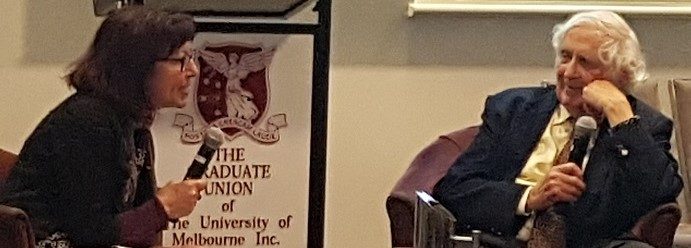by Francesca Beddie, blog editor…
In his discussion of historians and their craft, Tom Griffiths (The Art of Time Travel, 2016) describes Geoffrey Blainey* as magpie. It is a metaphor Blainey has also used for his research. Griffiths explains:
Blainey prods the earth inquisitively, feeds quirkily…he scavenges bright details and oddments that catch his eye. His voice is rich, his song mellifluous! He flies about the terrain and perceives broad patterns below…he doesn’t concede ground and can launch surprising attacks, especially in defence of his nest.
Asked by Michelle Rayner in an interview conducted at the Professional Historians’ conference in Melbourne on 19 August 2016, Blainey agreed the comparison was apt. The great thing about being a professional historian, he explained, was that you are pushed into territory you don’t know (great unless the push turns into a disaster!). In his case, somewhat to his own surprise, he had even written a history of the world (A Short History of the World, 2000).
In a talk which displayed humility and a wry charm, Blainey discussed his own history making and the importance of history for Australia.
After graduating from the University of Melbourne, Blainey’s first professional assignment was a commission to write the history of the Mount Lyell Mining and Railway Company in Queenstown, Tasmania. There he collected material inter alia by experiencing the mines and by doing interviews with ordinary people, people who didn’t like him taking notes while they talked. Blainey learned just to listen. Listening helped train his own memory. It also struck him, later when interviewing more educated people, that those with limited education have much better recall. They do not rely on books to retrieve the facts nor did they feel tempted to alter their recollections of the past.
Blainey experienced the ups and downs of the freelancer. Once The Peaks of Lyell (1954) was finished, he was without a job, so he went prospecting in Tasmania and also spent weeks in the library.
Griffiths describes Blainey as a ‘public historian before his time’. Even after he gained academic posts, he undertook other commissions. Blainey stressed during the interview that it was much easier to insist on writing without management interference when a company approached him with a proposal, rather than when he, the historian, instigated an idea.
Despite there being so much good history being published today, Blainey thinks that history as a discipline should be more confident. It needs to assert itself into debates in other fields. Scientists, he argues, should take more notice of historical trends before declaring absolutes. After all, history is the reservoir of human experience. It deserves greater attention. Asked if this might be achieved by having the position of a chief historian – to mirror that of the chief scientist – Blainey was doubtful. The breadth of the discipline was the problem. He was more inclined to the idea of establishing a chair in public history that could stimulate up and coming historians, whether young or old, and help them to appreciate history’s role in understanding the shape of Australian life.
*Emeritus Professor Geoffrey Blainey AC is a prominent Australian academic, public historian, author and teacher.
Photo by F. Beddie: Geoffrey Blainey in conversation with Michelle Rayner

Thanks Francesca – I’m sorry I missed the interview!, and I won’t look at a magpie the same way again the next time I see one …
It was a great interview with an inspiring man. I particularly like his suggestion of a chair in public history – in NSW perhaps?